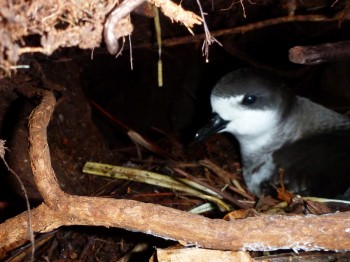David Duffy and Paula Capece (Pacific Cooperative Studies Unit, Department of Botany, University of Hawai’i Manoa, Honolulu, Hawai’i, USA) write in the open-access journal Marine Ornithology on the dangers of mongooses preying upon Vulnerable Hawaiian Petrels Pterodroma sandwichensis and Endangered Newell’s Shearwaters Puffinus newelli on the North Pacific island of Kaua’i.
The paper’s abstract follows:
“Small Indian Mongooses Herpestes javanicus have until recently been absent from the island of Kaua’i, Hawai’i. In anticipation of required management, we examine evidence that mongooses may be a significantly more dangerous predator than cats Felis catus for burrowing seabirds, particularly the endangered Hawaiian Petrel Pterodroma sandwichensis and threatened Newell’s Shearwater Puffinus newelli. Mongooses are small enough to enter burrows, allowing them to take eggs, nestlings and adults. In contrast, cats appear too broad to enter any but the widest burrows, so they tend to attack adults and young when these come to the burrow mouth. Given that these seabird species no longer persist in any numbers at low elevations on islands where mongooses are present, and that Kaua’i is one of the lowest of the main Hawaiian islands, if resources are limited, local control or eradication of mongooses would be a higher priority for management than control of cats or rats Rattus spp., although control of just one predator might result in increases in the others. The most important management action is to keep mongooses off islands where they are not already established.”

Hawaiian Petrel, photograph by André Raine
Reference:
Duffy, D. C. & Capece, P.I. 2014. Depredation of endangered burrowing seabirds in Hawai’i: management priorities. Marine Ornithology 42: 149-152.
John Cooper, ACAP Information Officer, 27 October 2014

 English
English  Français
Français  Español
Español